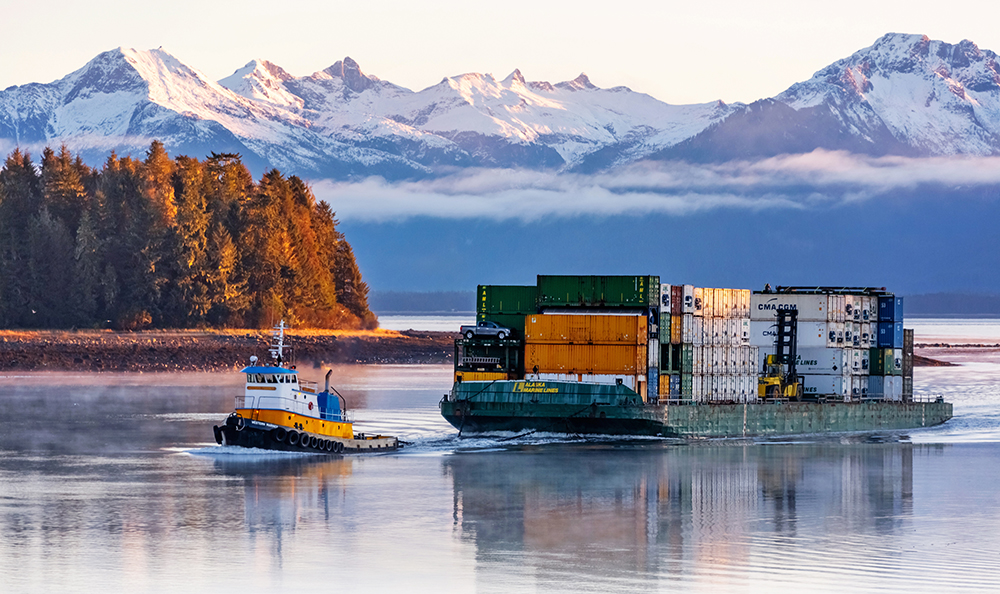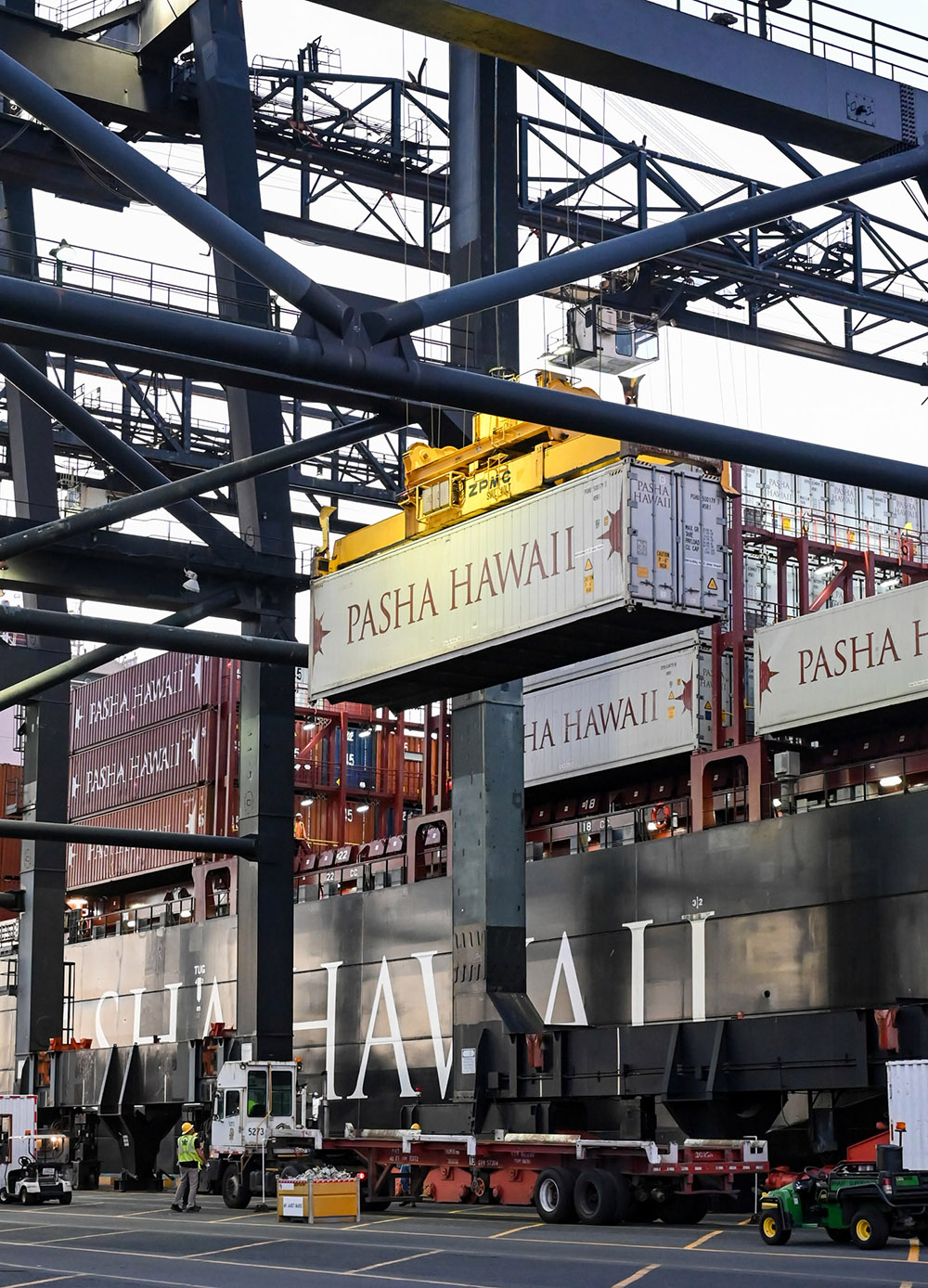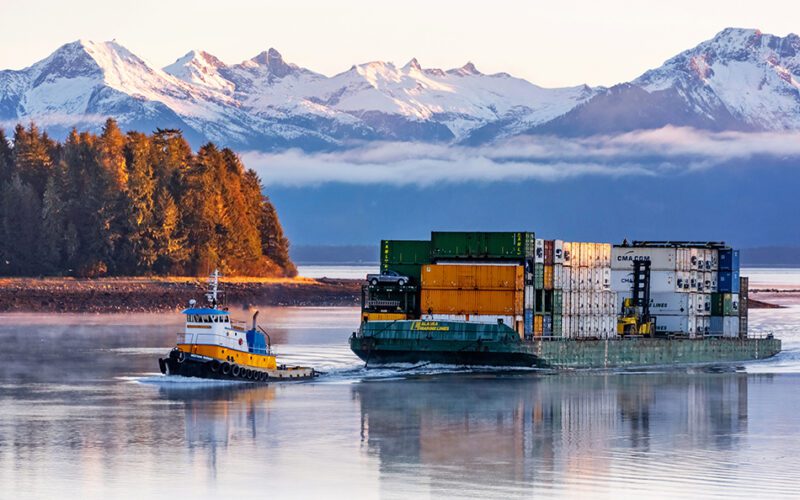
The Alaska and Hawaii regions are in the midst of transformation and recovery.
The Port of Alaska is not only undertaking long-awaited infrastructure projects to keep goods flowing in the future, the port itself may soon undergo a name change. In July, a panel recommended renaming it the Don Young Port of Anchorage to honor the longtime congressman who died in 2022. A final decision is expected by the state Assembly in the coming weeks.
In Hawaii, the community continues to work toward recovery after an August wildfire killed an estimated 97 people, displaced at least 11,000 others and caused an estimated $5.5 billion in property damage, according to a Reuters report.
The disaster prompted the public and private sectors to ensure the flow of goods and emergency supplies to the region. The Hawaii Department of Transportation waived wharfage fees for cargo coming to Kahului Harbor, while maritime shipping companies such as Pasha Hawaii and Matson Inc. prioritized supply and equipment shipments.
“Hawaii is a special place and the spirit of aloha and caring for one another is very evident, not only on Maui, but on all neighbor islands as well,” Pasha Hawaii President and CEO George Pasha IV said. “The community’s resilience, resourcefulness and spirit of giving on Maui are truly inspiring.”
Long-term, maritime industries in both states continue to see big investment, whether in the construction of state-of-the-art vessels or plans for new terminals able to accommodate larger cargo ships.
Here’s a look at what the public and private sector are up to in Alaska and Hawaii:
Port of Alaska
The next 10 years are expected to be critical for the Port of Alaska, which is moving forward on a $1.8 billion effort to replace and modernize aging facilities that are eroding at an accelerated rate because of water corrosion, Port Director Steve Ribuffo said.
“We have a very significant corrosion problem that has gotten to the point where we probably have somewhere between eight and 10 years of useful life left on the existing facilities before we have to start backing down on (how much) weight we can put on the dock because of the loss of structural integrity to the steel,” he explained. “And that’s if Mother Nature doesn’t throw us a curveball.”
With decades-old facilities beyond repair, the port’s plan calls for demolishing and replacing them with new facilities based on current industry standards for marine terminals, Ribuffo said.
In the fall of 2022, the port completed the first step in its modernization program, the $219 million replacement of a petroleum and cement terminal. The facility already is in use while the port is wrapping up certification of the petroleum lines so tankers and barges can begin delivering petroleum to the terminal by spring 2024, Ribuffo said.
Meanwhile, two projects totaling about $200 million are currently underway, one of which is the construction of new office space for port staff. Removing the current port office building, currently located on the dock, would better accommodate cargo ships and pave the way for the construction of the new terminals, Ribuffo said. Staff are expected to move into the new building by mid-spring 2024.
The other project is North Extension Stabilization Step One, work to strengthen a vital segment of the poorly constructed North Extension, part of a failed intermodal expansion project in 2009.
Construction started this year to remove fill and brace the remaining soil with cement, thanks in part to a $68.7-million federal grant the port received in 2022. Ribuffo said it will go a long way to helping vessels safely navigate in the space and park at cargo terminals.
Also moving forward are efforts to replace two cargo terminals. The city of Anchorage Assembly in July approved the design of Terminal 1 and decided to look at two options for the design of Terminal 2. The Assembly also approved a plan for the long-term financing of the program, which includes implementation of a new user surcharge expected to take effect on Jan. 1.
The port is reviewing the 35% design package for Terminal 1 and expects to receive the rest of the package in mid-to-late December, Ribuffo said, adding that he anticipates construction to begin in 2025.
He stated that he hopes a design decision on Terminal 2 would be made by the end of the first quarter of 2024.
Renovated NOAA Facility
In August, the National Oceanic and Atmospheric Administration saw the completion of a newly renovated facility in Ketchikan, Alaska.
The $18.7 million project, performed by Alaska-based Ahtna Infrastructure & Technologies, features new office space, a floating pier, boat ramp and utility system upgrades. It is NOAA’s Alaskan home base for its science and research work.
The facility also supports NOAA’s research vessels and the ship Fairweather, which is homeported in Ketchikan.
“This state-of-the-art facility positions us to better support emerging technologies, such as uncrewed systems, and be more efficient in our operational readiness for Alaska-focused science,” said Rear Adm. Chad Cary, deputy director of the NOAA Commissioned Officer Corps and NOAA Marine and Aviation Operations. “It also positions us closer to the Arctic, which will continue to grow in importance for our fisheries and seafloor mapping missions.”

Lynden
Lynden, which has a network of firms offering transportation and logistics solutions globally, continues to bolster its footprint in both Hawaii and Alaska.
Over the summer, barge-service provider Alaska Marine Lines opened a new rail service dock to meet the growing demand of seafood shipments from Alaska pollock producers.
From January to May, Alaska Marine Lines handled about 5.5 million pounds of pollock and cod in the U.S. and expected to move more from June to October.
“We’ve had a lot of customer interest in our new rail service dock in Seattle,” Alaska Marine Lines and Aloha Marine Lines Vice President of Sales Bret Harper said.
Many customers need to move their products down from Alaska and to locations throughout the Lower 48, he said.
“Our rail service dock was built exactly for that purpose and helps to connect Alaska with efficient freight networks around the country,” Harper said. “The rail service dock is designed to handle transfers from refrigerated containers to refrigerated rail cars, so even temperature-sensitive products like seafood can be safely and confidently shipped to their final destinations.”
Lynden has been working on a number of ventures in both regions in the past year. Among them: a project with longtime partner STG Construction to deliver a turbine from Seattle to Stebbins, Alaska, and a 300-ton crane to support the installation. The effort took five different Lynden companies to accomplish.
“The sheer amount of support equipment from all over Western Alaska and the crane that we moved from Seattle to Bethel, then on to Stebbins, made this an extremely challenging move,” Marine Operations Manager Brian Ward said.
In 2024, Lynden plans to launch the Makani Loa, a new 438-foot-long, 105-foot-wide Makani Class barge specifically built for regular bi-weekly service between Seattle and Honolulu.
The barge, with a deadweight capacity of more than 16,000 tons and 22-foot-high cargo bin walls, joins sister barges Kamakani and Namakani, recent additions to the fleet and among the fastest and most fuel-efficient barge designs built, according to Lynden.
Their presence in the fleet has raised the company’s cargo capacity to Hawaii by 35% since Lynden purchased them in 2020, the company has said.
Lynden also said that it plans to continue innovating its processes and equipment. For example, the company is offering 102-inch-wide, 53-foot-long containers and platforms.
“The extra width and height provide increased cubic capacity to make shipping more efficient, and they have proven very popular on our Seattle-to-Hawaii route,” Harper said. “We also feature ‘Kaptive Beam’ decking systems that allow freight to be stacked higher in the container without crushing the bottom pallets, so space can be safely and efficiently maximized.”
The company also invests in technology to help its customers. For instance, customers can sign up to receive email updates as their shipment status changes, so they always know when to expect the next load of supplies needed for their project or business operations, the company said. Later this year, Lynden plans to begin rolling out enhancements to its tracking tools.

Pasha
Pasha Hawaii’s activities in the region continue to flourish with the welcoming of m/v Janet Marie, the second of its two new ‘Ohana Class container vessels, earlier this year.
This ship joins m/v George III, which began service in August 2022. Both run on natural gas, making these the first two vessels in Hawaii to do so, according to Pasha.
Meanwhile, Pasha continues to partner with the Hawaii Department of Transportation Harbors (HDOT) and Hawaii Harbors User Group on efforts to develop a new Kapalama Container Terminal (KCT) on Oahu, which is expected to be completed in 2024.
Phase 1 of the project, budgeted at $174 million, was completed in March 2021 and includes a 65.9-acre container yard, entry and exit gates, security fencing, gantry cranes, container-handling equipment and a truck-weigh station.
Phase 2, budgeted at about $352.5 million, is under construction. It includes an 18.5-acre container yard, 1,863 linear feet of added berthing capacity, dredged waterfront and harbor channel, wider Piers 40 and 41 to receive bigger inter-island vessels, a reconstructed Pier 41 and pier upgrades to increase roll-on/roll-off cargo operations.
“Once it is operational, Pasha Hawaii’s sister company, Hawaii Stevedores, will be able to implement first-class cargo-handling equipment and to utilize complementary cargo-handling capabilities to achieve an outstanding level of customer service,” Pasha explained in a statement.
The company has supported the state’s efforts in renewable energy, including the KES battery storage project in Kapolei. Pasha helped ship 172 Tesla large-scale rechargeable lithium-ion batteries, known as “Megapacks,” in the fourth quarter of 2022.
“This site is charged by surrounding solar- and wind-power generation to keep the grid balanced and ensure overproduction is not wasted,” Pasha said.

Last July, officials broke ground on the Kuihelani solar project in Maui, the largest in the state, occupying 450 acres in the old sugar cane properties. Other projects include the Kupono solar farm in Ewa Beach, on 131 acres, and the Halekuewehi solar farm on the Big Island, on 300 acres.
“These projects involve solar energy production with battery farms to store the excess supply and put energy back into the grid when needed at night and during inclement weather,” Pasha said.
For the year, Pasha Hawaii forecasts cargoes continuing to fill the weekly allocated space the company has on Jean Anne and Marjorie C. Pasha also anticipates recovery work to continue due to the Maui wildfires and higher-than-normal demand for remediation work in Maui.
Besides the vast amounts of debris from structures that needs to be processed, consolidated and shipped out, there are more than 4,000 burned vehicles and a hundred burned and sunken boats in Lahaina Harbor that need to be recovered and moved to landfills on the mainland, Pasha said.
This, according to the company, will require a steady flow of machinery, dump trucks and containment equipment for the next several years.
The region is prioritizing relief efforts to help with economic recovery, Pasha said.
“We are seeing some preliminary market signals for stronger tourism-related shipments, as Americans are receiving the message that keeping your trip or vacation to other areas of Maui besides West Maui is also a way you can help support the residents and their families and livelihoods,” the company said in a statement.
Matson
Honolulu-based Matson Inc. announced in November 2022 that subsidiary Matson Navigation Co. had inked an agreement with Philly Shipyard Inc. to construct three 3,600-TEU Aloha Class container vessels valued at about $1 billion.
Philly Shipyard previously constructed two other Aloha Class vessels that went into service in 2018 and 2019, as well as four Jones Act containerships for the company between 2003 and 2006.
“It is the ultimate compliment when a former customer returns for another project,” Philly Shipyard president and chief executive officer Steinar Nerbovik said in November. “We are proud of the six vessels previously delivered to Matson and are again ready to execute and deliver this important project.”
The new 854-foot vessels, anticipated to be delivered in 2026 and 2027, will include dual fuel engines that can run on traditional marine fuels or liquefied natural gas, fuel-efficient hull design and “environmentally safe double hull fuel tanks and freshwater ballast systems,” according to the company.
Once built, the new vessels would replace three ships in Matson’s China-Long Beach Express (CLX) service. Those vessels would then replace a trio of older ships in its Alaska service, providing larger, speedier ships in that trade lane, the company said.
“These new Jones Act compliant vessels will be built specifically for our China-Long Beach Express service, and like their sister ships, are expected to help Matson achieve its 2030 greenhouse gas emissions reduction goal while also providing additional capacity and speed benefitting our Hawaii service as well as the CLX,” company Chairman and Chief Executive Officer Matt Cox said.
Karen Robes Meeks, a Southern California native, is an award-winning journalist with more than 20 years’ writing experience. Her articles have appeared in the Los Angeles Times, San Francisco Chronicle, Orange County Register and Long Beach Press-Telegram, where she worked as a reporter for nearly 14 years. Her work has been recognized by the California News Publishers Association, the Associated Press News Executives Council and the Los Angeles Press Club. She can be reached at karen@maritimepublishing.com

